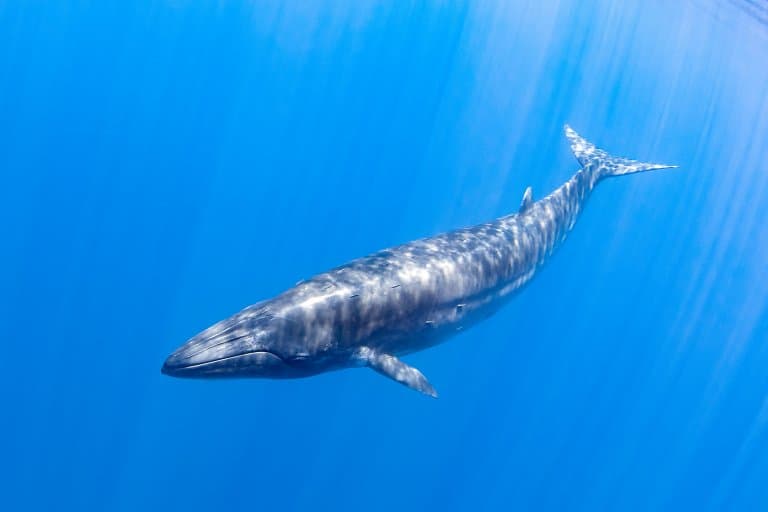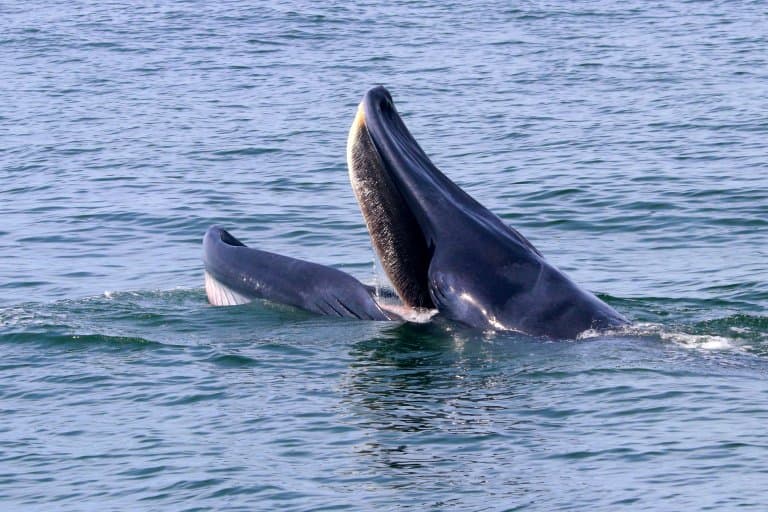Bryde’s Whale Profile
This is another animal that was spared by its size from the whaler’s harpoon for most of the Golden Age of Whaling, but was targeted more recently as all the big whales started mysteriously disappearing.
Yet, Bryde’s whales might be several whale species, and it’s hard to know which you’re looking at, even if you’re a professional. They are a baleen whale belonging to the largest group known as rorquals, which includes the blue whale, humpback whale, and more.

Bryde’s Whale Facts Overview
| Habitat: | Tropical and warm temperate waters |
| Location: | Worldwide |
| Lifespan: | Unknown |
| Size: | 12 m (39 ft), maybe up to 15 meters |
| Weight: | Up to 25 metric tons |
| Color: | Grey/blue on top, white/pink throat and belly |
| Diet: | Small schooling fishes |
| Predators: | None as an adult, orca may take the calves |
| Top Speed: | 24 kph (15 mph) |
| No. of Species: |
2, maybe |
| Conservation Status: |
Data deficient/least concern (IUCN) |
Bryde’s whales are exceptionally eel-like rorquals, related to sei and blue whales, but don’t grow quite as long. They differ so subtly from sei whales, that they’re a pain to study, but they’re interesting nonetheless.
Capable of feeding on copious amounts of copepods, they make use of a neat trick commonly seen in humpbacks to hunt.
These are shy, but inquisitive animals that hold onto their secrets very well.
Their estimated population size is between 90,000 – 100,000 worldwide and they are classified as least concern by the IUCN, although reliable data is insufficient.
Interesting Bryde’s Whales Facts
1. They’re a bunch of whales
It’s hard to classify what exactly a Bryde’s whale is. Their taxonomy is still being defined, so for now Bryde’s whales may be two or three closely-related species, perhaps even more, that are hard to tell apart.
Even countless Japanese research fleets have struggled to figure it out, and seem to be distracted by researching the larger, tastier species of whale.
Bryde’s whales make up what’s called a species complex, which is essentially a taxonomist’s admission of ignorance. Despite being one of the largest animals on the planet, and one of the most common whales left in the ocean, we still don’t really know much about them.

2. They also look like other whales
Another reason they’re hard to pinpoint is that they resemble unrelated whales, particularly the sei whale, which is a similar size but tends to grow to longer lengths.
Whalers and researchers both have struggled to tell them apart, and in many cases have to rely on being able to spot the ridges on the animal’s head to know which is which.
While both sei and Bryde’s whales dive without raising their tails out of the water, a Bryde’s whale will arch its back before a dive, whereas a sei won’t.
This tiny detail is one of the few clues as to the difference as an observer and may go part way to understanding how difficult is to know what a Bryde’s whale actually is! 1
3. They’re big-headed
One thing we can tell you is that their skulls are enormous. They’re also really long. The narrow body and elongated head make for a very worm-like appearance.
A Bryde’s whale’s head is around a quarter of its length, and then it just keeps going. These long, sleek whales reach up to 12 meters from nose to tail.
They’re smaller than their rorqual cousins and the sperm whale, but much more streamlined, with a low profile. 2

4. They can eat over 600kg of food per day
This feasting occurs in daily cycles and feeding behaviour depends on where they are on the planet. Californian populations usually feed around dawn and dusk, whereas in Madeira and New Zealand, they feast during the daytime.
In the Gulf of Thailand, they’ve figured out that the lack of oxygen in deeper waters keeps fish near the surface, so all they have to do is float at the top of the water column with their mouths open and catch their prey as it jumps in.
Multiple populations lunge at schools of fish, sometimes at depth, other times at the ocean surface, and in New Zealand, they’ve been seen slapping their heads on the water to herd zooplankton.
In one way or another, a Bryde’s whale will consume about 4% of its body weight in ocean critters each day during peak feeding time. 3
5. They use bubble net foraging
One of the ways they feed is by using a technique commonly seen in Humpback whales, called bubble-net foraging.
This is where groups or individual whales will surround schools of fish or krill and release bubbles of air from depth, surrounding and herding them into a ball that can be easily gulped down in one. 4
6. They are shy but curious
Bryde’s are reportedly very shy animals, often fleeing from boats as they’re approached. But on occasion, they’re said to approach of their own accord, swimming alongside the boat and peering in.
They don’t seem to enjoy each other’s company much, either, rather choosing to swim alone or in small groups of two or three.
They’ll come together when there’s food though, and are often seen in groups of up to eight, sharing a ball of fish. 5
7. They still get hit by boats a lot
Marine traffic seems to be ever-increasing, and collisions with ocean traffic are becoming more common.
Vessel strikes are a real problem for whales, and they’re often under-reported. From the records, Bryde’s whales are sixth-most affected, but being smaller than other rorquals, they probably don’t get spotted as often either.
Most vessel strikes are recorded from beached whale carcasses, but there will be many more that never wash up. Many live sightings are of individuals with deep propeller scars on their backs. 6

8. They have been known to gulp divers
The ocean is the setting for many tall tales and being swallowed by a whale is probably the most biblical of all, but in this instance, luckily, there’s a photo of it.
While baleen whales are incapable of swallowing large prey items, they’re more than capable of holding them inside their enormous mouths, and one lucky diving instructor got first-hand experience of this when a Bryde’s whale gulped a fish ball he happened to be inside.
This has happened before with humpbacks, and always as a mistake. On both counts, the divers were released, unharmed, as soon as the whale realised its mistake. 7
9. They were not significantly targeted by commercial whalers
Historically, commercial whalers did not target this species heavily, but it became more important in the 1970s as the industry depleted other targets.
Fortunately, they were not hunted to almost extinction like many other whale species.
10. Orca have been witnessed chasing and killing bryde’s whales
Orca will hunt the Bryde’s whale, in a similar way that they will target the fin whale, or minke whale.
In 2011, a filmmaker named Michael Fishbach captured a 20-tonne (20,000-kg) Bryde’s whale being hunted and killed by a herd of 20 orca in the Sea of Cortez.
Bryde’s Whale Fact-File Summary
Scientific Classification
| Kingdom: | Animalia |
| Phylum: | Chordata |
| Class: | Mammalia |
| Order: | Artiodactyla |
| Family: | Balaenopteridae |
| Genus: | Balaenoptera |
| Species: | Bryde’s Whale Complex |
Fact Sources & References
- “Species Spotlight: Bryde’s Whales vs Sei Whales”, Whale Watching Auckland.
- “Bryde’s whale”, International Whaling Commission.
- Rochelle Constantine (2018), “Future Directions in Research on Bryde’s Whales”, Frontiers.
- Hidehiro Kato (2018), “Bryde’s Whale”, Sci-Hub.
- “Bryde’s Whale in the Hauraki Gulf”, New Zealand Geographic.
- A. Athayde (2022), “A vessel collision report for Bryde’s whales (Balaenoptera brydei) off the northern coast of São Paulo, Brazil”, Research Gate.
- (2019), “Diver gets swallowed and spat out by a Bryde’s whale”, Surfer Today.
